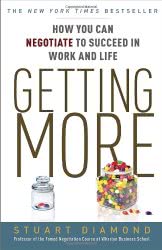It has been a while since I wrote my last book review and it was not exactly a great one, so I’ll try to improve on this by writing a few reviews over the next month or so. After all what better gift for geeks than books?
I have had the pleasure to read Getting More last October, as part of a work training. It’s a book about negotiation, and makes a point multiple times to detach that from the idea of it being manipulation, even though it’s probably up to you to see whether the distinction is clear enough for you. The author, Prof. Stuart Diamond, runs a negotiation course at Wharton, in Pennsylvania, and got famous with this.
I was expecting the book to be hogwash, as many other business books, and especially so as many materials I’ve been given before at courses (before my current job though). Turned out that the book is not bad at all and I actually found it enjoyable, even though a bit repetitive — but repetita iuvant as they say; the repetition is there to make you see the point, not just for the sake of being there.
The main objective of the book is to provide you with process and tools to use during negotiation, big-time business deals and everyday transactions alike. It also includes example on how to use this with your significant other and children, but I’ll admit I just skipped over them altogether as they are not useful to me (I’m single and I don’t even see my nephew enough to care about dealing with children.)
It was a very interesting read to me because, while I knew I’m not exactly a cold-minded person especially when frustrated, I found that some of the tools described I’ve been using, for a long time, without even knowing about their existence. For example, when I interviewed for my current job, my first on-site interviewer arrived with a NERV sticker on his laptop — we spent a few minutes talking about anime, and not only that reassured me a lot about the day, – you have no idea how stressed I was, as I even caught a fever the day before the interview! – it also built an “instantaneous” connection with someone who did indeed become a colleague. I would think it might have added to his patience for my thicker than usual accent that day, too.
Between anecdotes and explanations, the book has another underlying theme: be real. This is the main point of difference between negotiation and manipulation as seen from the book. In the more mundane case of dealing with stores, hotels and airlines, you have two main examples of using the techniques, to get compensated for something negative that happened, whether or not it was in control of the other party, and otherwise to ask penalties waived when you did something incorrect, unintentionally. It would be tempted to cause something negative and ask for compensation even if everything was perfect — that would be manipulation, and it’s unlikely to work very well unless you’re a good -actor- liar, and rather makes it worse for the rest of the world.
The book invites you to keep exercising the tools daily — I have been trying but it’s definitely not easy especially if you’re not an extrovert by nature. It takes practice and, especially at the beginning, more time than it would be worth: arguing half an hour for a fifteen euro discount somewhere is not really worth it to me, but on the other hand practice makes perfect and the processes to apply for small and big transactions the same. I have indeed been able to get some ~$100 back at the Holiday Inn I’ve stayed at in San Francisco.
I have got my set of reserves on using the methods described on the book – it sometimes feels manipulative and relying on implicit privilege – but on the other hand, Prof. Diamond points out multiple time that the methods works best when both parties know about them, so spreading the word about the book is a good idea, and telling people explicitly what you’re doing is the best strategy.
Indeed, I felt that I would have gotten better from Tesco just last week, if they had read the book and applied the same methods. A delivery was missed, and that was fine, but then the store went incommunicado for over ten hours instead of calling me right away to reschedule, and the guy who called me lied on the order going to be new the day after. They gave me some €25 back straight on the card — which is okay for me, but it was not really in their best interest, as I could have walked away with the money and gone to a different store. I asked them if they could offer me some months of their DeliverySaver (think Amazon Prime for groceries) for free.
Yes, the DeliverySaver subscription would have had a much higher value (€7.5/month), but it would be actually cheaper to them (as I live in an apartment complex, that they delivery to daily anyway, the delivery costs are much lower than that), and it would have “forced” me to come back to them, rather than going to a competitor such as SuperValu. As it turns out, I’ve decided to stick with Tesco, mostly because I have their credit card and it is thus still convenient to stay a customer. But I do think they could have made a better deal for themselves.
At any rate, the book is worth a read and the techniques are not completely worthless, even though difficult to pull off without being a jerk. It requires knowing a lot about a system to do so, but again this is something that is up to the people reading the book.
